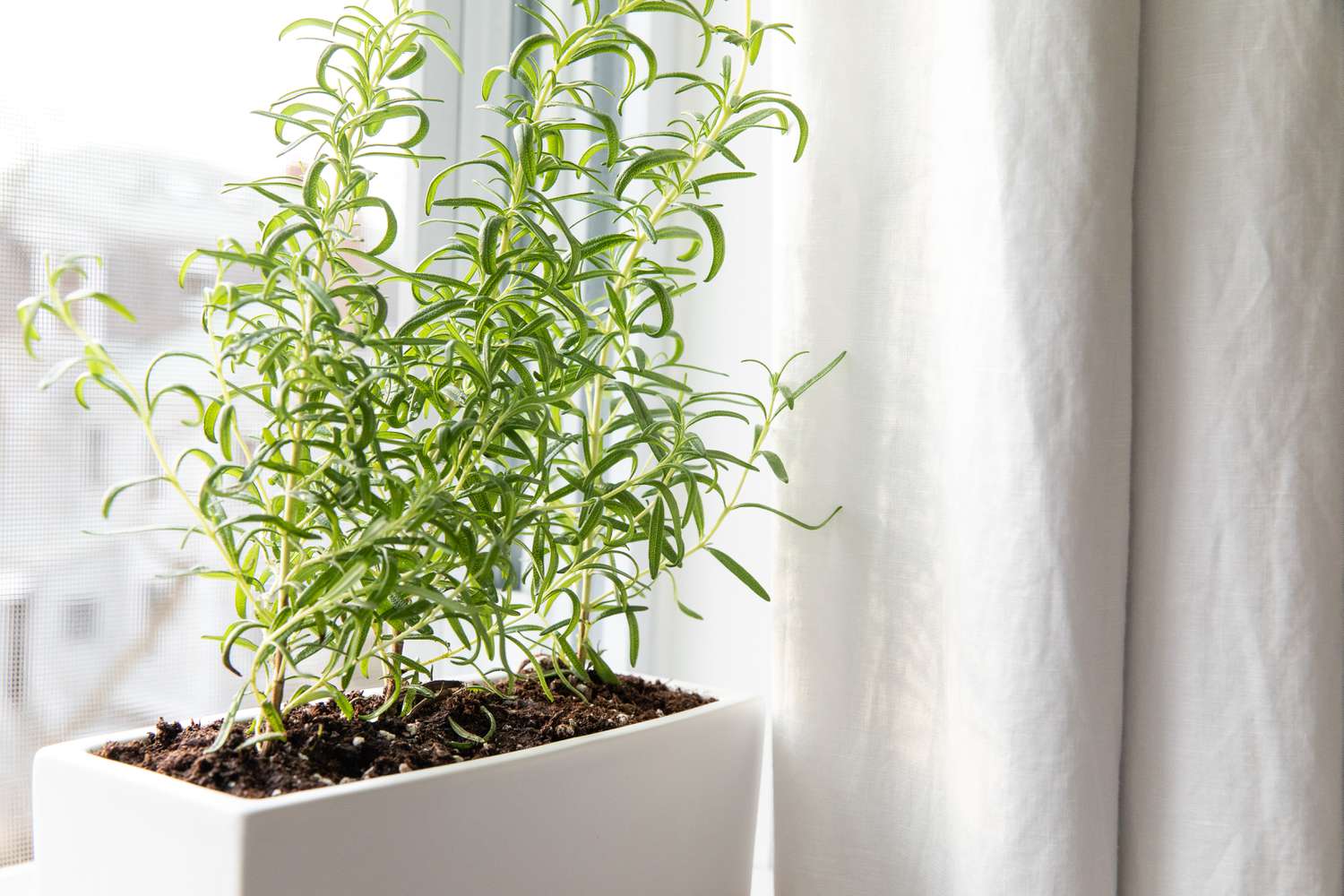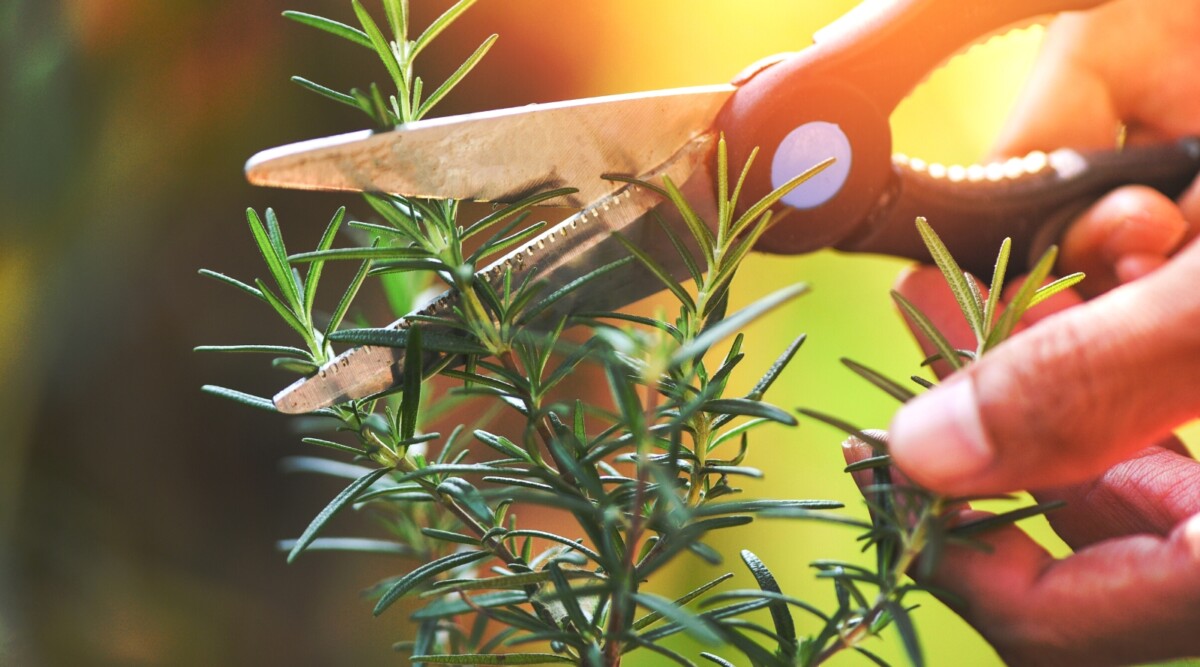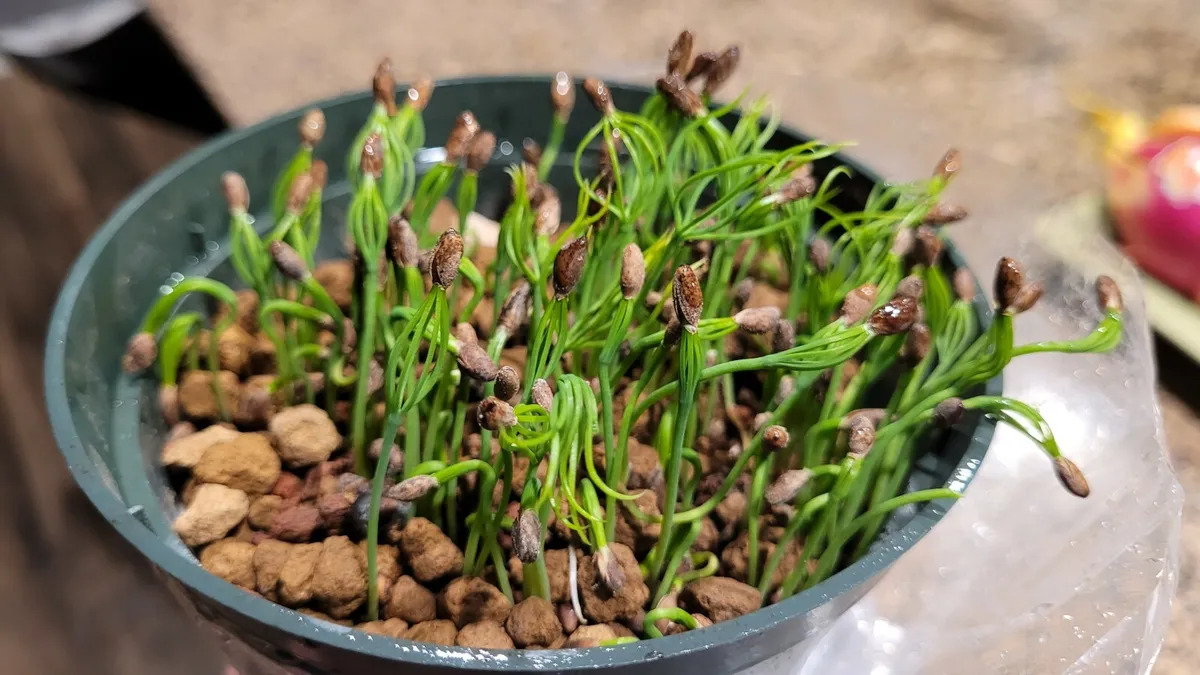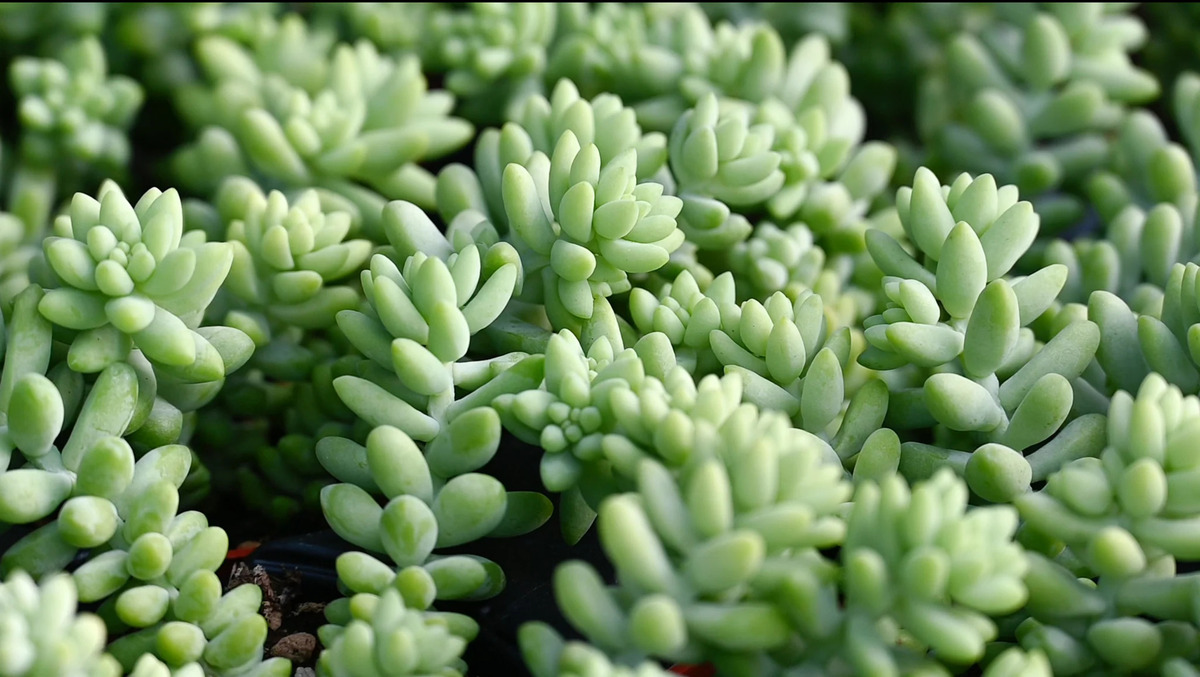Home>Gardening Techniques>Plant Care>How To Care For Rosemary Plant Indoors


Plant Care
How To Care For Rosemary Plant Indoors
Modified: February 9, 2024
Learn the essential plant care tips for growing rosemary indoors. Discover how to properly care for your rosemary plant to ensure its health and longevity.
(Many of the links in this article redirect to a specific reviewed product. Your purchase of these products through affiliate links helps to generate commission for Chicagolandgardening.com, at no extra cost. Learn more)
Table of Contents
Introduction
Welcome to the wonderful world of indoor plant care! If you’re a plant enthusiast looking to add some greenery to your home, the rosemary plant is an excellent choice. Not only does it bring a touch of elegance to any space, but it also offers a myriad of benefits. From adding flavor to your culinary creations to providing a refreshing aroma, this versatile herb is a must-have in every plant lover’s collection.
Whether you’re a beginner or an experienced gardener, this comprehensive guide will walk you through the essentials of caring for a rosemary plant indoors. We will explore everything from choosing the right location for your plant to maintaining the ideal temperature and humidity levels. You’ll also learn the art of watering, fertilizing, pruning, and repotting, ensuring your rosemary plant thrives and flourishes.
By understanding and implementing proper care techniques, you can enjoy abundant, aromatic rosemary all year round. So, let’s roll up our sleeves, put on our gardening gloves, and embark on this exciting journey of caring for your indoor rosemary plant.
Choosing the Right Location
When it comes to finding the perfect spot for your indoor rosemary plant, there are a few key factors to consider. First and foremost, you’ll want to select a location that receives ample sunlight. Rosemary plants thrive in bright, direct sunlight for at least six hours a day. Place your plant near a south-facing window or any spot that offers maximum exposure to sunlight.
In addition to sunlight, it’s important to consider the ambient temperature and humidity of the room. Rosemary plants prefer a consistent temperature between 60 to 70°F (15 to 21°C). Avoid placing your plant near drafty windows, air conditioning vents, or heating sources, as these can cause fluctuations in temperature and create stress for your rosemary.
Furthermore, rosemary plants appreciate a humid environment. You can increase humidity by placing a tray filled with water near the plant or using a humidifier. This will help mimic the natural conditions of rosemary’s native Mediterranean habitat. However, be cautious not to overwater the plant directly, as excessive moisture can lead to root rot. Striking the right balance between humidity and proper drainage is key.
Lastly, consider the airflow in the room. Good air circulation is important for preventing fungal diseases and maintaining the overall health of your rosemary plant. Avoid placing your rosemary in a stagnant corner or an area with poor airflow. Instead, choose a location with some gentle air movement, such as near an open window or a fan set on low.
By carefully choosing the right location for your indoor rosemary plant, you’ll provide it with the optimal conditions for growth and ensure its long-term health and vitality.
Providing Adequate Sunlight
Sunlight is one of the most essential factors for the healthy growth of your indoor rosemary plant. As a Mediterranean herb, rosemary thrives under bright, direct sunlight. When selecting a spot for your plant, aim to provide it with at least six hours of sunlight each day.
One of the easiest ways to ensure your rosemary receives sufficient sunlight is by placing it near a south-facing window. South-facing windows receive the most sunlight throughout the day, making them ideal for sun-loving plants like rosemary. If you don’t have a south-facing window, east or west-facing windows can also provide adequate sunlight, although the duration may differ.
If your indoor space doesn’t have enough natural light, you can supplement it with artificial lighting. LED grow lights are an excellent option for providing the necessary light spectrum for plant growth. Position the grow lights about 6 to 12 inches above the rosemary plant, and keep them on for around 12 to 14 hours a day. This will ensure your rosemary receives the right amount of light for healthy photosynthesis.
Keep in mind that while rosemary loves sunlight, it’s important not to expose it to excessive heat. If the temperature near the window gets too hot, it can stress and damage the plant. To prevent this, you can use sheer curtains or blinds to filter the intensity of the sunlight without blocking it completely. This will help maintain the right balance of light and temperature for your rosemary.
Regularly monitor your rosemary plant for signs of sunburn, such as yellowing or browning of the leaves. If you notice any signs of sunburn, adjust the position of your plant to a spot with slightly less direct sunlight. Remember, finding the right balance is crucial to keep your rosemary healthy and thriving.
Providing adequate sunlight is essential for the overall growth and well-being of your indoor rosemary plant. By creating the right light conditions, you’ll encourage lush foliage, strong stems, and aromatic leaves that can be used in a variety of culinary delights.
Temperature and Humidity Requirements
Creating the ideal temperature and humidity conditions is crucial for the health and growth of your indoor rosemary plant. As a native of the Mediterranean region, rosemary prefers a moderate climate with warm summers and mild winters.
The optimal temperature range for rosemary is between 60 to 70°F (15 to 21°C). It’s important to maintain a consistent temperature within this range to avoid stress on the plant. Avoid placing your rosemary plant near drafty windows, doors, or heating vents, as these can cause temperature fluctuations. Additionally, keep it away from areas that experience extreme temperatures, such as near radiators or air conditioning units.
In terms of humidity, rosemary plants prefer a slightly higher humidity level than what is typically found in most homes. To create a favorable environment, you can increase humidity by placing a tray filled with water near the plant. As the water evaporates, it will raise the humidity around the plant. Another option is to use a humidifier to maintain an ideal humidity level of around 40 to 60 percent. However, be cautious not to overwater the plant directly, as excessive moisture can lead to root rot.
If you live in a particularly dry climate or during winter when central heating can dry out the air, you can also mist the leaves of the rosemary plant with water. This will provide a temporary boost of humidity and prevent the leaves from drying out. Be sure to use room temperature water and avoid misting the plant excessively, as this can promote fungal growth.
Proper ventilation and air circulation are also vital for the health of your rosemary plant. Good airflow helps prevent the buildup of stagnant air, which can lead to diseases. Avoid placing your rosemary in a cramped or cluttered space. Instead, choose an area with some gentle air movement, such as near an open window or a fan set on low.
By providing the right temperature and humidity conditions, you’ll create a comfortable and thriving environment for your indoor rosemary plant. This will promote vigorous growth, vibrant foliage, and ensure that your plant remains in optimal health throughout the year.
Watering the Rosemary Plant
Proper watering is essential for the growth and well-being of your indoor rosemary plant. While rosemary is a drought-tolerant herb, it still requires regular watering to thrive. However, it’s important to strike a balance and avoid overwatering, as this can lead to root rot and other water-related issues.
Before watering your rosemary, always check the moisture level of the soil. Stick your finger about an inch into the soil. If it feels dry to the touch, it’s time to water your plant. If the soil still feels slightly moist, wait a day or two before checking again.
When watering your rosemary, it’s best to use the “soak and dry” method. This means thoroughly watering the plant until the water runs out through the drainage holes of the pot. Allow the excess water to drain completely before placing the pot back in its saucer or decorative container. Avoid leaving your rosemary sitting in standing water, as this can lead to root rot.
One important thing to remember is that rosemary prefers slightly drier conditions compared to many other indoor plants. Overwatering can be detrimental to the plant’s health. It’s best to underwater rather than overwater, as rosemary can tolerate short periods of dryness better than excessive moisture.
The frequency of watering depends on various factors such as the size of the pot, the type of soil, and the environmental conditions. In general, indoor rosemary plants typically require watering every 7-10 days. However, always adjust the watering schedule based on the specific needs of your plant. During the winter months, when the plant is in its dormant phase, reduce the frequency of watering to prevent waterlogging.
It’s worth noting that rosemary plants are very sensitive to the quality of water. They prefer slightly acidic to neutral water with a pH level between 6.0-7.0. If your tap water is alkaline, you can adjust the pH level by adding a small amount of vinegar or citric acid to the water.
By following these watering guidelines and paying attention to your rosemary plant’s specific needs, you’ll provide it with the moisture necessary for healthy growth. Remember to strike a balance and avoid overwatering to ensure the long-term vitality of your indoor rosemary.
Fertilizing the Plant
Fertilizing is an important aspect of caring for your indoor rosemary plant. While rosemary generally doesn’t require heavy feeding like some other plants, providing the right nutrients will help promote stronger growth and enhance its overall health and vigor.
During the active growing season, which typically occurs in spring and summer, it’s recommended to fertilize your rosemary every 4-6 weeks. You can use a balanced, water-soluble fertilizer specifically formulated for herbs or vegetables. Make sure to follow the instructions on the packaging for the recommended dosage and frequency.
When applying fertilizer, dilute it with water to avoid overfeeding the rosemary. Too much fertilizer can lead to chemical burn and damage the roots. It’s best to err on the side of caution and use a slightly weaker concentration than what is recommended by the manufacturer.
Additionally, it’s important to avoid fertilizing during the winter months when the plant is in its dormant phase. During this time, the plant’s growth slows down, and it requires less nutrients. The focus should instead be on maintaining proper watering and providing adequate light and temperature conditions.
Another organic option to nourish your rosemary plant is to use compost. You can mix well-decomposed compost into the potting soil or add a thin layer as a top dressing. This will slowly release nutrients into the soil and provide a natural source of food for your plant.
While fertilizing is important, it’s essential not to overfertilize your rosemary. Excessive amounts of fertilizer can cause salt buildup in the soil, leading to nutrient imbalances and damage to the roots. If you notice any signs of fertilizer burn, such as yellowing or browning of the leaves, flush the soil with water to leach out the excess salts.
Observing your rosemary plant’s growth and overall health is key to determining if it needs fertilization. If the plant is growing vigorously and has healthy, vibrant foliage, it may not require frequent fertilizing. On the other hand, if growth is stunted or the leaves appear pale or yellowish, it may be a sign that your rosemary plant needs a nutrient boost.
By providing the right balance of nutrients through regular fertilization, you’ll help your indoor rosemary plant thrive and flourish, ensuring it remains healthy and productive throughout its lifetime.
Pruning and Trimming
Pruning and trimming are essential practices for maintaining the shape, size, and overall health of your indoor rosemary plant. Regular pruning not only helps keep the plant compact and bushy but also encourages new growth and enhances its aromatic qualities.
The best time to prune your rosemary plant is in the spring, just before it enters its active growth period. This allows for the removal of any dead or damaged branches and encourages the development of new shoots. Using a pair of clean and sharp pruning shears, carefully trim back any overgrown or straggly branches. Aim to maintain an overall balanced and symmetrical shape.
When pruning, it’s important not to remove more than one-third of the plant’s total foliage at once. Over-pruning can take a toll on the rosemary’s energy reserves and result in weakened growth. Instead, opt for lighter and regular pruning sessions throughout the growing season to gradually shape the plant and encourage new growth.
While pruning, it’s also a good practice to remove any yellowing or dead leaves. These leaves can provide a breeding ground for pests and diseases if left unattended. Removing them not only improves the plant’s appearance but also helps maintain its overall health.
Trimming is another technique that can be used to shape and maintain your rosemary plant. Trimming involves the regular snipping of the plant’s tips to promote branching and denser foliage. This can be done using sharp scissors or pruning shears. Focus on trimming the tips of the branches rather than cutting into the woody stems. Regular trimming encourages the growth of new shoots and helps keep the rosemary compact and tidy.
As you prune and trim your rosemary plant, take the opportunity to check for any signs of pests or diseases. Common pests that can affect rosemary include aphids, spider mites, and whiteflies. If pests are present, treat them promptly using organic insecticidal soap or neem oil sprays, following the instructions on the packaging. Regular pruning can help control the spread of pests by eliminating their breeding grounds and improving air circulation around the plant.
Remember to clean and sterilize your pruning tools after each use to prevent the spread of any diseases or pests. Wiping them with rubbing alcohol or a diluted bleach solution is a simple and effective way to ensure that your tools remain clean and free from contaminants.
By practicing regular pruning and trimming, you’ll not only keep your indoor rosemary plant looking neat and well-maintained but also promote its growth, enhance its aroma, and prevent the onset of pests or diseases.
Dealing with Pests and Diseases
Like any plant, rosemary is susceptible to certain pests and diseases. However, with proper care and regular monitoring, you can prevent and effectively manage these issues to keep your indoor rosemary plant healthy and vibrant.
One of the most common pests that can affect rosemary is aphids. These tiny insects feed on the sap of the plant and can cause leaf curling and stunted growth. To get rid of aphids, start by spraying the affected areas with a strong stream of water to dislodge them. You can also use insecticidal soap or neem oil, following the instructions on the product label. Repeat the treatment every few days until the aphid infestation is under control.
Another pest that can lurk on rosemary plants is spider mites. These minuscule pests feed on the undersides of leaves, causing yellowing and webbing. To combat spider mites, regularly check your plants for any signs of infestation. You can use a forceful spray of water to knock them off the plant or use insecticidal soap specifically formulated for spider mites.
Whiteflies are another common nuisance that can plague rosemary. These tiny, white flying insects can cause yellowing leaves and sticky honeydew residue. To control whiteflies, try using yellow sticky traps to catch and monitor adult flies. Additionally, beneficial insects such as ladybugs and lacewings can be introduced to the indoor environment to help control whitefly populations.
When it comes to diseases, rosemary is generally quite resilient. However, it can occasionally suffer from root rot if overwatered or planted in poorly draining soil. To prevent root rot, avoid overwatering and ensure that the pot has proper drainage holes. If you suspect root rot, trim away any affected roots, repot the plant in fresh, well-draining soil, and adjust your watering practices accordingly.
Powdery mildew can also develop on rosemary plants, especially in humid conditions. This fungal disease presents as a white, powdery coating on the leaves. To prevent powdery mildew, ensure adequate air circulation around the plant by placing it in a well-ventilated area. If powdery mildew does occur, remove the affected leaves and treat the plant with a fungicidal spray specifically designed for powdery mildew.
Regularly inspecting your rosemary plant for any signs of pests or diseases is crucial for early detection and prompt intervention. By practicing good cultural care, such as providing proper sunlight, ventilation, and watering, you can create an environment that promotes the plant’s natural defenses against pests and diseases.
Remember to always read and follow the instructions on any pest control products or treatments you use. If you’re unsure about the best course of action, consult with a local gardening expert or horticulturist for personalized advice.
By staying vigilant and taking appropriate action, you can prevent and manage pests and diseases, ensuring that your indoor rosemary plant stays healthy and thrives in your care.
Repotting the Rosemary Plant
Repotting is an important aspect of caring for your indoor rosemary plant. Repotting allows the plant to have adequate space for its roots to grow and ensures the overall health and longevity of the plant. Knowing when and how to repot your rosemary will help it thrive in its new home.
One indication that your rosemary plant needs to be repotted is if it becomes root-bound. This happens when the roots outgrow the current pot and start to encircle the root ball. You may notice roots protruding from the drainage holes or the plant becoming top-heavy and unstable. Typically, rosemary plants benefit from repotting every 1-2 years.
Spring is the ideal time to repot your rosemary plant when it’s entering its active growth phase. Before repotting, choose a pot that is one size larger than the current one, ensuring it has drainage holes to prevent waterlogging. Use a well-draining potting mix with a combination of peat moss, perlite, and sand, which mimics the well-draining soil conditions rosemary prefers.
To begin the repotting process, gently remove the rosemary plant from its current pot. Carefully loosen the roots to disentangle them. If the roots are tightly bound, you can lightly tease them apart to encourage new growth. Remove any dead or decaying roots in the process.
Place a layer of fresh potting mix at the bottom of the new pot, ensuring it’s deep enough to accommodate the root ball. Position the rosemary plant in the center of the pot and add more potting mix around the sides, gently firming it down to eliminate any air pockets. Leave some space at the top to allow for proper watering.
After repotting, thoroughly water the plant to settle the soil and help the roots establish in their new environment. Keep in mind that after repotting, the plant may need some time to adjust. During this period, it’s important to avoid overwatering, as the newly disturbed roots may be more sensitive to excess moisture.
After repotting, place the rosemary plant in a location that receives ample sunlight and provides the optimal temperature and humidity conditions. Monitor the plant closely in the weeks following repotting to ensure it is adjusting well and showing signs of new growth.
Repotting not only provides your rosemary plant with fresh nutrients and room to grow, but it also allows you to inspect the root system for any signs of disease or pests. It’s a great opportunity to assess the plant’s overall health and make any necessary adjustments to its care routine.
By repotting your rosemary plant at the right time and providing it with the appropriate growing conditions, you’ll give it the best chance to thrive and continue providing you with aromatic foliage for your culinary endeavors.
Harvesting and Using Fresh Rosemary
One of the joys of growing indoor rosemary is the ability to harvest and use its fragrant leaves in a variety of culinary dishes. Harvesting the leaves at the right time and knowing how to use them will ensure the best flavor and aroma in your recipes.
Rosemary leaves can be harvested at any time once the plant has reached a suitable size. It’s best to wait until the plant is at least 6 to 8 inches tall before harvesting. This allows the plant to establish itself and ensures that you have enough foliage to use in your cooking.
When harvesting, use a pair of clean and sharp pruning shears or scissors to snip off the tender, young stems. Avoid removing more than one-third of the plant’s foliage at once to avoid stressing the plant. You can also gently pinch off the leaves if the stems are too thin to cut.
Harvesting rosemary is a wonderful sensory experience. As you cut the stems, the aromatic oils will be released, filling the air with its delightful fragrance. Enjoy this moment and appreciate the fresh, earthy scent that rosemary offers.
Once you’ve harvested the rosemary leaves, it’s time to put them to use in your culinary creations. Rosemary pairs well with various dishes, from roasted meats and vegetables to soups, stews, and even baked goods. The leaves can be used fresh or dried, depending on your preference.
To use fresh rosemary, simply strip the leaves from the stem by running your fingers along the stem in the opposite direction of growth. Chop or mince the leaves finely before adding them to your recipes. Fresh rosemary adds a bold and aromatic flavor, enhancing the taste of your dishes.
If you prefer to use dried rosemary, hang the harvested stems upside down in a cool, dry place for about two weeks. Once the leaves are dry and brittle, gently remove them from the stems and store them in an airtight container. Dried rosemary can be used in the same way as fresh, but note that the flavor will be more concentrated, so adjust the quantity accordingly.
When using rosemary in cooking, it’s important to remember that a little goes a long way. Start with a small amount and taste as you go, adding more if desired. The sharp and pine-like flavor of rosemary can easily overpower other ingredients if used in excess.
In addition to its culinary uses, rosemary can also be utilized in various DIY projects and natural remedies. Its fragrant leaves can be used to make herbal sachets, potpourri, infused oils, or herbal teas.
By harvesting and using fresh rosemary from your indoor plant, you’ll have a constant supply of this delightful herb to enhance the flavors and aromas of your favorite dishes, bringing a touch of the Mediterranean into your kitchen.
Conclusion
Caring for an indoor rosemary plant is a rewarding and enjoyable experience. By providing the right conditions of sunlight, temperature, and humidity, you can create a thriving environment for your rosemary to flourish. Regular watering, fertilizing, and pruning will ensure the plant remains healthy, while proper repotting techniques and pest management will contribute to its long-term vitality.
Harvesting the aromatic leaves of your rosemary plant and incorporating them into your culinary creations adds a delightful flavor and aroma to your dishes. Whether you’re a seasoned chef or an enthusiastic home cook, fresh rosemary is a valuable ingredient that can elevate your recipes and bring a touch of the Mediterranean to your plate.
Remember to approach the care of your indoor rosemary plant with patience and observation. Each plant is unique and may have slightly different needs. By observing the plant and making adjustments as necessary, you’ll become attuned to its specific requirements and be able to provide tailored care.
As you embark on this plant care journey, don’t forget to enjoy the process. Gardening is a wonderful way to connect with nature and experience the joy of nurturing a living organism. Take the time to appreciate the vibrant green foliage, the invigorating scent, and the sense of accomplishment that comes with successfully caring for your indoor rosemary plant.
So, embrace the role of a plant caregiver and create a thriving oasis for your rosemary plant in the comfort of your own home. With your knowledge, love, and attention, your indoor rosemary will reward you with its beauty, fragrance, and the opportunity to enhance your culinary creations for years to come.










